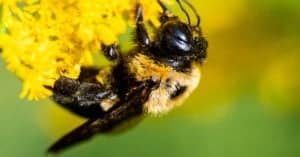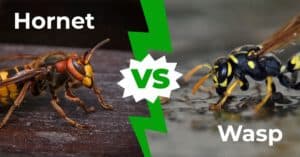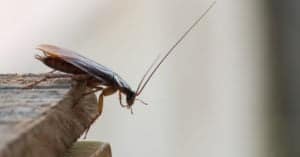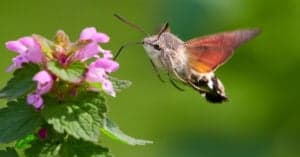10 Incredible Honeybee Facts
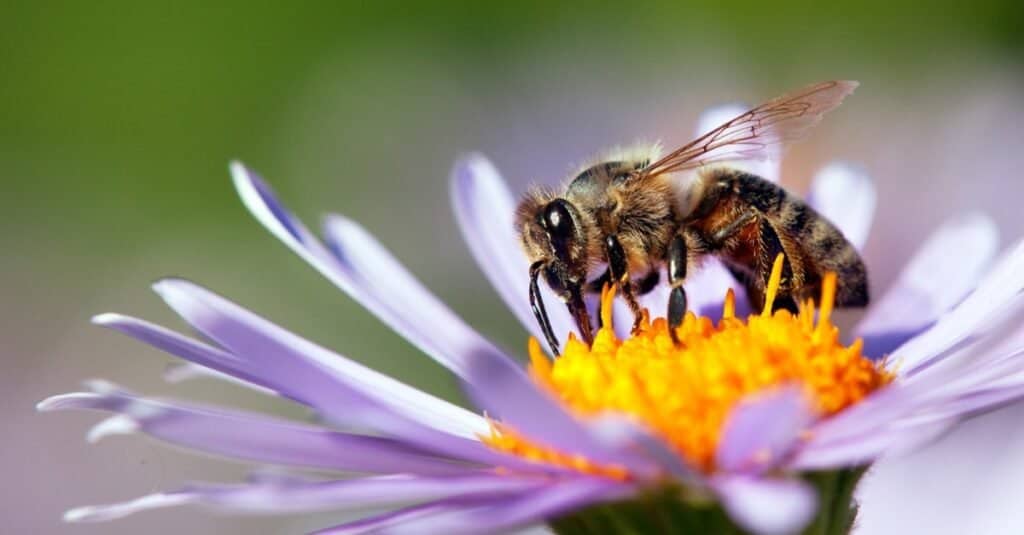
Daniel Prudek/Shutterstock.com
Honeybees are perhaps one of the most important creatures that we have here on earth. Not only do these animals help sustain our human population, but other animals and ecosystems rely on these insects as well. Part of the Insecta class and the Hymenoptera order, honeybees are hardworking, intelligent, and amazing creatures. Let’s learn more incredible facts about these impressive insects!
1. They Are Responsible For The Production And Storage Of Honey
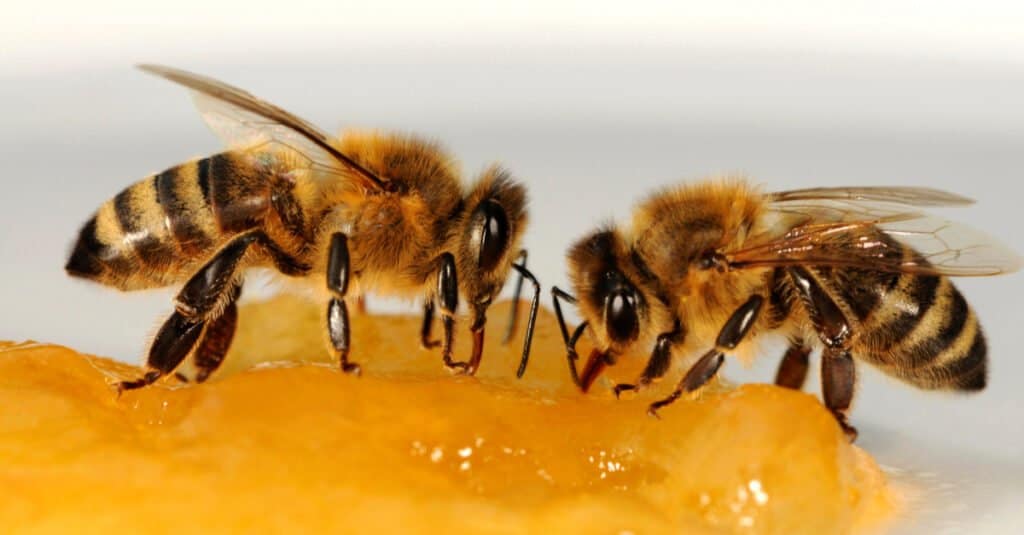
schubbel/Shutterstock.com
Honeybees produce and store honey. They collect floral nectar, which is broken down into sugars and stored in a honeycomb, a hexagonal wax structure used to store honey and eggs. Honeybees flap their wings to generate liquid honey after storing sugars in the honeycomb. A honeybee colony can generate 10 to 200 pounds of honey annually. This disparity is due to honey predators, dangers, and natural resources.
2. They Have Large Colonies Ruled By A Queen Bee
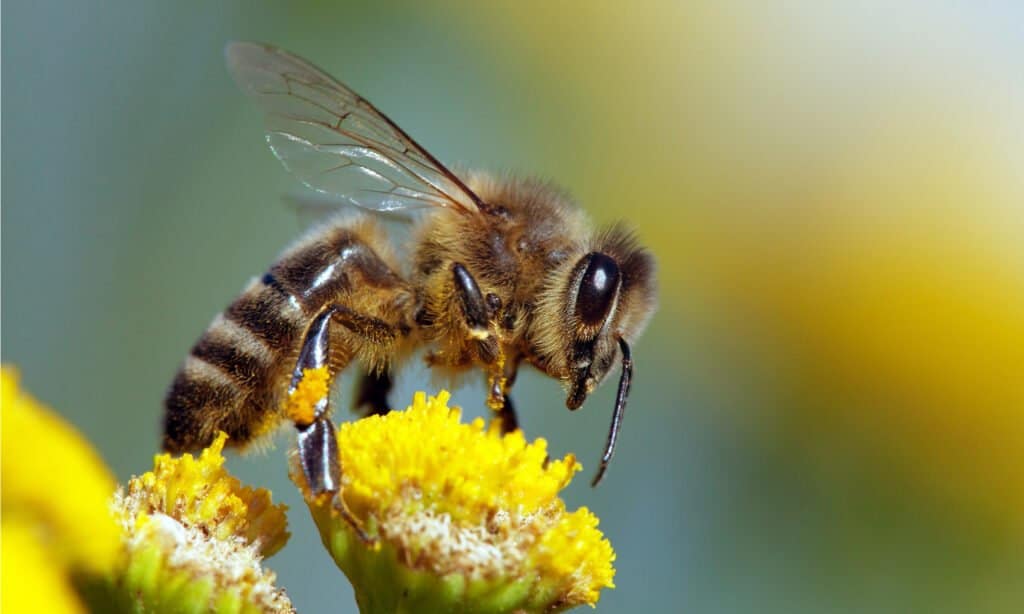
Daniel Prudek/Shutterstock.com
Honeybees live and operate in huge colonies. These colonies have 20,000 female worker bees, hundreds of male drones, and a single queen. The Queen is a mated adult female bee whose fertilized eggs hatch to become worker bees or the next queen. Nurse bees gather 10 to 20 freshly hatched female larvae. They feed them a rigorous diet of royal jelly to select the queen bee.
3. Their Life Cycle Is Very Structured
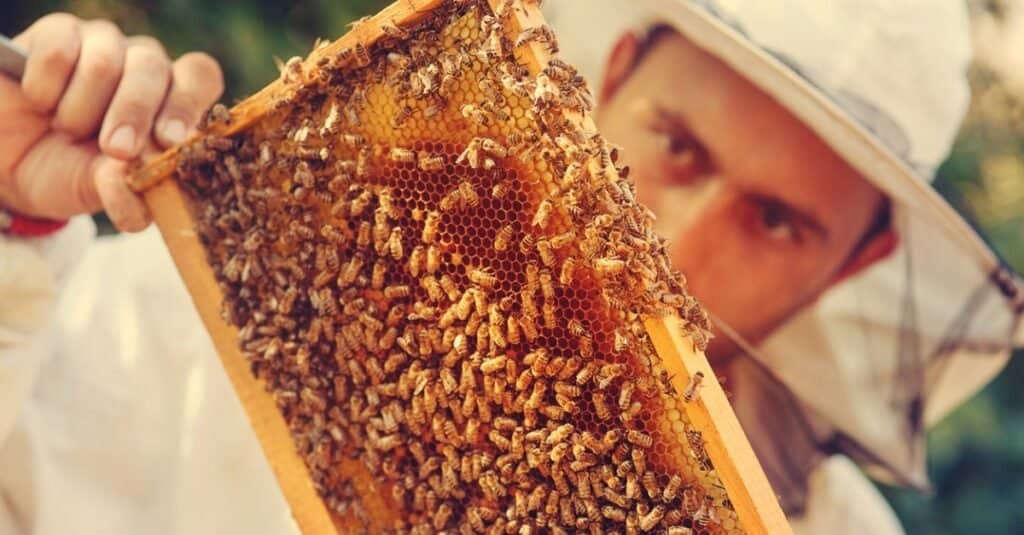
A honeybee’s life is regimented and often divided into jobs. Once the eggs hatch into larvae, they take on new jobs. Some larvae become nursing bees, who clean the hive and feed the larvae. Worker bees find food and use bee dance to communicate food sources. Queens that don’t mate become drones. Drones, which can number 500, are kicked out of the hive over the winter because they don’t protect it or even have stingers. Some worker bees and drones will become queens.
4. They Are Extremely Important Pollinators
A honeybee, like most other bees, serves a key role on our planet, which is pollination. Pollination is provided when bees or other pollinators gather pollen from one flower and carry it to another. This key role not only helps ecosystems thrive, but it also improves food production. They contribute to food security and nutrition for almost all forms of life here on earth. The honeybee itself provides incredibly valued pollination for a very wide variety of crops.
5. Humans Are Not The Only Animals That Rely On Honeybees

Aleksandr Rybalko/Shutterstock.com
While both honey and pollination from honeybees are extremely important for a human’s food source and survival, many other animals rely on honeybees as well. Animals such as skunks, raccoons, opossums, honey badgers, bears, and many more use raw honey as a source of nutrition. Not only that, but plants and crops also rely on honeybees’ pollination to thrive. These plants feed many other animals and insects as well.
6. They Are The Reason Why We Have Beekeepers
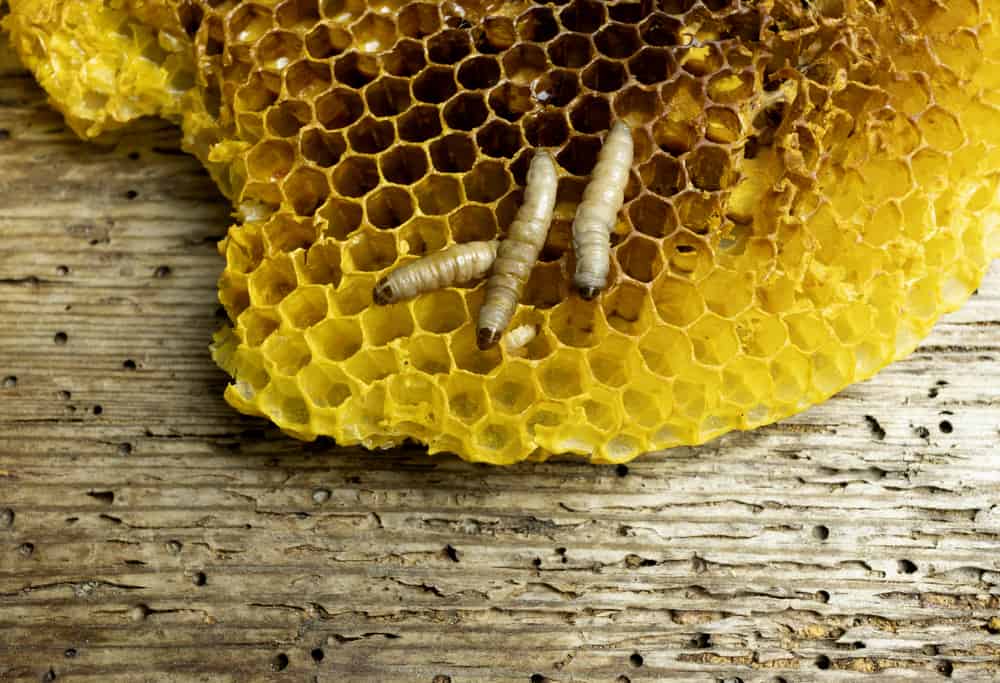
Sendo Serra/Shutterstock.com
Beekeepers are people who own and breed beehives, usually to produce honey. In the late 1930s, beekeepers came about to produce and sell honey across the United States and other countries. Although, that is just in the United States. The first form of beekeeping began nearly 5,000 years ago in ancient Egypt. Currently, beekeeping is incredibly crucial to maintaining the declining population of bees throughout the planet.
7. They Provide More Than Just Honey
Although honeybees are known primarily for producing honey, they provide a lot more than just this sweet liquid and pollination. In fact, honeybees also contribute to the production of beeswax, which is used in many different areas. This includes modern medicine and science. Honeybees also produce royal jelly, propolis, and venom, which are also collected for both nutritional and medicinal purposes. They are also responsible for producing nectar and even bee bread, which is a mixture of pollen, nectar, or honey.
8. Their Main Form Of Defense Lies In Their Stingers

WIRACHAIPHOTO/Shutterstock.com
Honeybees utilize their stingers to defend themselves from predators. The bee’s stinger is hollow and needle-like. It has two rows of barbed blades that produce venom. It is normally harmless to people unless they are allergic to it. Only worker bees and the queen have stingers, but a queen won’t use hers until fighting another queen. Honeybees perish horribly after stinging because their stingers are amputated.
9. They Have An Interesting Form Of Communication
Honeybees use two diverse ways to communicate, movement and odor. They use these forms of communication as a way of signaling to the rest of the hive there is a nearby food source or threat. When a honeybee wants to communicate that there is nectar nearby, she will do a waggle-like dance to signal to other bees. As for odor, they use their pheromones to locate their hive or new home after a swarm occurs.
10. Currently, There Are Only 8 Surviving Species Of Honeybees
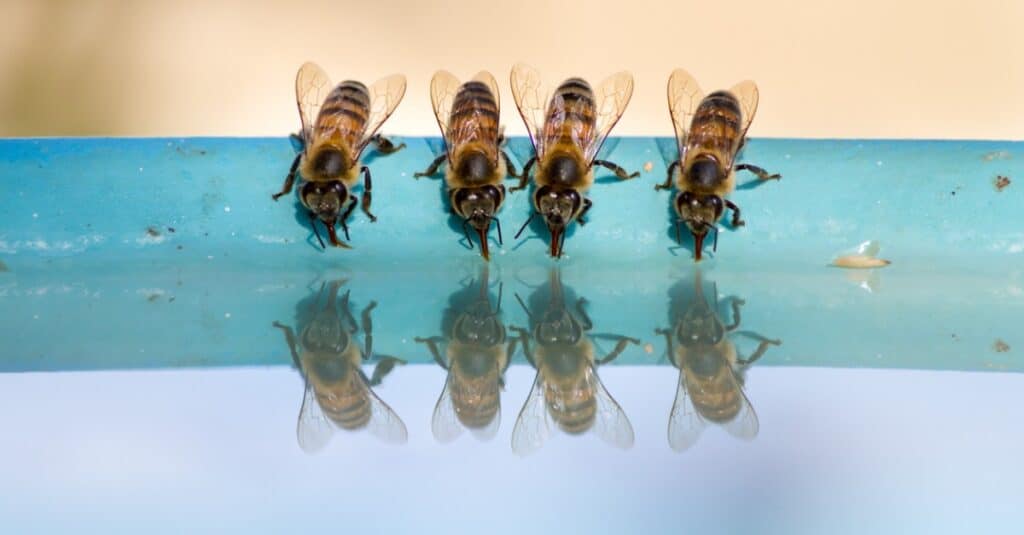
iStock.com/EcaterinaLeonte
While historically 7 to 11 species of honeybees were recognized, at this time there are only 8 surviving species. This is due to many factors such as deadly mites, climate change, and habitat destruction. Not only are these factors a leading cause, but the use of pesticides has also created a significant decline in this important species. Therefore, protecting bees and their habitats is crucial, not only for the honeybees themselves but for many species and organisms on the planet.
More from A-Z Animals

Daniel Prudek/Shutterstock.com
Honeybees are perhaps one of the most important creatures that we have here on earth. Not only do these animals help sustain our human population, but other animals and ecosystems rely on these insects as well. Part of the Insecta class and the Hymenoptera order, honeybees are hardworking, intelligent, and amazing creatures. Let’s learn more incredible facts about these impressive insects!
1. They Are Responsible For The Production And Storage Of Honey

schubbel/Shutterstock.com
Honeybees produce and store honey. They collect floral nectar, which is broken down into sugars and stored in a honeycomb, a hexagonal wax structure used to store honey and eggs. Honeybees flap their wings to generate liquid honey after storing sugars in the honeycomb. A honeybee colony can generate 10 to 200 pounds of honey annually. This disparity is due to honey predators, dangers, and natural resources.
2. They Have Large Colonies Ruled By A Queen Bee

Daniel Prudek/Shutterstock.com
Honeybees live and operate in huge colonies. These colonies have 20,000 female worker bees, hundreds of male drones, and a single queen. The Queen is a mated adult female bee whose fertilized eggs hatch to become worker bees or the next queen. Nurse bees gather 10 to 20 freshly hatched female larvae. They feed them a rigorous diet of royal jelly to select the queen bee.
3. Their Life Cycle Is Very Structured

A honeybee’s life is regimented and often divided into jobs. Once the eggs hatch into larvae, they take on new jobs. Some larvae become nursing bees, who clean the hive and feed the larvae. Worker bees find food and use bee dance to communicate food sources. Queens that don’t mate become drones. Drones, which can number 500, are kicked out of the hive over the winter because they don’t protect it or even have stingers. Some worker bees and drones will become queens.
4. They Are Extremely Important Pollinators
A honeybee, like most other bees, serves a key role on our planet, which is pollination. Pollination is provided when bees or other pollinators gather pollen from one flower and carry it to another. This key role not only helps ecosystems thrive, but it also improves food production. They contribute to food security and nutrition for almost all forms of life here on earth. The honeybee itself provides incredibly valued pollination for a very wide variety of crops.
5. Humans Are Not The Only Animals That Rely On Honeybees

Aleksandr Rybalko/Shutterstock.com
While both honey and pollination from honeybees are extremely important for a human’s food source and survival, many other animals rely on honeybees as well. Animals such as skunks, raccoons, opossums, honey badgers, bears, and many more use raw honey as a source of nutrition. Not only that, but plants and crops also rely on honeybees’ pollination to thrive. These plants feed many other animals and insects as well.
6. They Are The Reason Why We Have Beekeepers

Sendo Serra/Shutterstock.com
Beekeepers are people who own and breed beehives, usually to produce honey. In the late 1930s, beekeepers came about to produce and sell honey across the United States and other countries. Although, that is just in the United States. The first form of beekeeping began nearly 5,000 years ago in ancient Egypt. Currently, beekeeping is incredibly crucial to maintaining the declining population of bees throughout the planet.
7. They Provide More Than Just Honey
Although honeybees are known primarily for producing honey, they provide a lot more than just this sweet liquid and pollination. In fact, honeybees also contribute to the production of beeswax, which is used in many different areas. This includes modern medicine and science. Honeybees also produce royal jelly, propolis, and venom, which are also collected for both nutritional and medicinal purposes. They are also responsible for producing nectar and even bee bread, which is a mixture of pollen, nectar, or honey.
8. Their Main Form Of Defense Lies In Their Stingers

WIRACHAIPHOTO/Shutterstock.com
Honeybees utilize their stingers to defend themselves from predators. The bee’s stinger is hollow and needle-like. It has two rows of barbed blades that produce venom. It is normally harmless to people unless they are allergic to it. Only worker bees and the queen have stingers, but a queen won’t use hers until fighting another queen. Honeybees perish horribly after stinging because their stingers are amputated.
9. They Have An Interesting Form Of Communication
Honeybees use two diverse ways to communicate, movement and odor. They use these forms of communication as a way of signaling to the rest of the hive there is a nearby food source or threat. When a honeybee wants to communicate that there is nectar nearby, she will do a waggle-like dance to signal to other bees. As for odor, they use their pheromones to locate their hive or new home after a swarm occurs.
10. Currently, There Are Only 8 Surviving Species Of Honeybees

iStock.com/EcaterinaLeonte
While historically 7 to 11 species of honeybees were recognized, at this time there are only 8 surviving species. This is due to many factors such as deadly mites, climate change, and habitat destruction. Not only are these factors a leading cause, but the use of pesticides has also created a significant decline in this important species. Therefore, protecting bees and their habitats is crucial, not only for the honeybees themselves but for many species and organisms on the planet.

